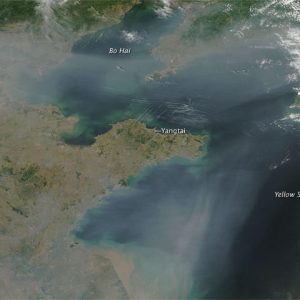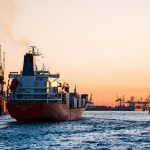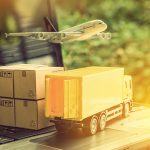Carrier Surcharges for China’s 2019 Low Sulfur Regulation Changes
China’s Ministry of Transport announced a while back upcoming changes to the country’s fuel regulations in regard to sulfur content and emissions. We’re fast approaching the implementation of the first major changes. The changes will come with costs to carriers, so the carriers, of course, plan to pass costs on to shippers through surcharges.
Those surcharges are listed at the end of this article.
Starting in the new year, 2019, China’s emission control areas (ECAs) will include the entire coast of China. Ships sailing within 12 nautical miles of the coastline will be subject to a 0.5% sulfur content limit on fuel. This limit includes when ships are berthing.

NASA Image of Pollution Haze Over China
Pollution has long been a problem in China where air quality has often been visible to the naked eye. In fact, the pollution haze has even been visible from space.
That China is showing commitment toward improving air quality is laudable. China’s effort even gets ahead of the International Maritime Organization’s (IMO) sulfur cap regulation changes that are also fast approaching.
The IMO has a 0.5% sulfur cap scheduled to hit the global ocean freight industry in 2020. We recently blogged about literal sail ships being one of the possible solutions for carriers to meet the upcoming regulations.
A 0.5% sulfur cap is pretty good, but it looks like that’s not going to be good enough for China. Starting in 2020, the plan in China is to reduce the sulfur content limit on fuel to 0.1% in the country’s ECAs with talk of increasing the ECAs to something like 20 nautical miles from the coastline instead of 12.
Those 2020 further increased fuel regulations are not set in stone. The country is still determining the feasibility, and it is likely how well implementation of the 2019 regulation changes go will also have an impact on implementation of the IMO-exceeding 2020 regulation plans.
To be clear, the 2019 fuel sulfur regulation change in China is quite significant. The current fuel sulfur cap there is 3.5%. Yes, switching fuels to go from 3.5% sulfur content to 0.5% does cost more money for carriers. So it is no surprise that this regulation would bring with it Low Sulfur Surcharges from carriers.
Of course, the surcharges announced by different carriers vary in amounts and the dates they go into effect.
Steven Chiu of Seamaster Global shared in an email to Universal Cargo a chart including the various Low Sulfur Surcharge amounts he has received announcements on so far. The charts include the surcharge amounts for the various standard shipping container sizes.
Steven also notes that the increase of ECAs coming from China’s Maritime Safety Administration (MSA) expands in the Bohai Sea Area and Pearl River Delta, effective on January 1st, 2019. He adds that the Hong Kong and Taiwan governments also announced the same procedure, aligning with China. This information is reflected in the charts Steven sent, which are broken into two phases.
Phase 1:
China Low Sulphur Surcharge applied for shipments loaded/transit at Shanghai, Ningbo, Nanjing, and Yangtze River area
|
Carrier |
Effective Date |
Loading |
Discharge |
Surcharge Amount |
|||
|
20’DC |
40’DC |
40’HC |
45’HC |
||||
|
ZIM |
1-Nov-18 |
Shanghai, Ningbo, Nanjing and Yangtze River area |
All Routing |
USD 20 |
USD 40 |
USD 40 |
USD 40 |
|
OOCL |
11-Nov-18 |
Shanghai, Ningbo, Nanjing and Yangtze River area |
West Coast |
USD 6 |
USD 8 |
USD 9 |
USD 10 |
|
OOCL |
11-Nov-18 |
Shanghai, Ningbo, Nanjing and Yangtze River area |
Non-West Coast |
USD 12 |
USD 15 |
USD 17 |
USD 19 |
|
PIL |
1-Dec-18 |
Shanghai, Ningbo, Nanjing and Yangtze River area |
All Routing |
USD 20 |
USD 40 |
USD 40 |
USD 40 |
|
YML |
1-Dec-18 |
Shanghai, Ningbo, Nanjing and Yangtze River area |
All Routing |
USD 16 |
USD 32 |
USD 32 |
USD 32 |
|
HMM |
6-Dec-18 |
Shanghai, Ningbo, Nanjing and Yangtze River area |
All Routing |
USD 20 |
USD 40 |
USD 40 |
USD 40 |
|
Hamburg SUD |
12-Dec-18 |
Shanghai, Ningbo, Nanjing and Yangtze River area |
All Routing |
USD 10 |
USD 20 |
USD 20 |
USD 20 |
|
ONE |
1-Jan-19 |
Shanghai, Ningbo, Nanjing and Yangtze River area |
All Routing |
USD 15 |
USD 30 |
USD 30 |
USD 30 |
Phase 2:
Low Sulphur Surcharge applied for shipments export, import, or transit in China, Hong Kong, and Taiwan
|
Carrier |
Effective Date |
Loading |
Discharge |
Surcharge Amount |
|||
|
20’DC |
40’DC |
40’HC |
45’HC |
||||
|
YML |
1-Dec-18 |
Shanghai, Ningbo, Nanjing and Yangtze River area |
All Routing |
USD 16 |
USD 32 |
USD 32 |
USD 32 |
|
YML |
1-Jan-19 |
North China |
All Routing |
USD 25 |
USD 50 |
USD 50 |
USD 50 |
|
YML |
1-Jan-19 |
South China, Pearl River Delta, Hong Kong |
All Routing |
USD 20 |
USD 40 |
USD 40 |
USD 40 |
|
EMC |
1-Jan-19 |
shipment loaded/transship at Taiwan, Hong Kong and China |
All Routing |
USD 20 |
USD 40 |
USD 40 |
USD 40 |
|
HMM |
6-Dec-18 |
China |
All Routing |
USD 20 |
USD 40 |
USD 40 |
USD 40 |
|
ZIM |
5-Jan-19 |
Cargo moving between China and USA/Canada/Panama/the Caribbean. |
All Routing |
USD 20 |
USD 40 |
USD 40 |
USD 40 |
|
APL |
1-Jan-19 |
Cargo moving between China and USA/Canada/Panama/the Caribbean. |
All Routing |
USD 5 |
USD 10 |
USD 10 |
USD 10 |
|
Hamburg SUD |
11-Jan-19 |
China, Taiwan, Hong Kong |
All Routing |
USD 12 |
USD 24 |
USD 24 |
USD 24 |
|
ONE |
1-Jan-19 |
China, Taiwan, Hong Kong |
All Routing |
USD 15 |
USD 30 |
USD 30 |
USD 30 |
|
Maersk |
1-Jan-19 |
Far East (excl. China) |
WC North America |
USD 26 |
USD 29 |
USD 29 |
USD 37 |
|
Maersk |
1-Jan-19 |
Far East (excl. China) |
East Coast North America |
USD 23 |
USD 25 |
USD 25 |
USD 32 |
|
Maersk |
1-Jan-19 |
China |
West Coast North America |
USD 38 |
USD 53 |
USD 53 |
USD 61 |
|
Maersk |
1-Jan-19 |
China |
East Coast North America |
USD 35 |
USD 49 |
USD 49 |
USD 56 |
|
SM Line |
1-Jan-19 |
China (including Hong Kong) |
All Routing |
USD 20 |
USD 40 |
USD 40 |
USD 40 |





Nice blog about China transportation. Everybody should read it to get new updates about China transportation. I like your article thank you!
FOB Shipment, shipper or consignee should bare the LSS charge?
From our understanding, LSS should be part of international charge, should be paid by consignee.